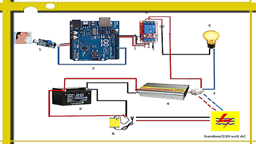Smart Home with Voice Control Lights Using Arduino Uno R3
Main Article Content
Abstract
The development of science and technology has positively impacted human life, which has now reached the age of electric voice commands. An intelligent home management system allows humans to operate their house's electrical gadgets, such as lighting, using simple voice commands, eliminating the need to move around to switch on or off equipment. When users of indoor lighting use sound waves to operate the system or turn on the lights, the sound sensor sends an input signal to the microcontroller, which is then processed with the microcontroller's output in the form of a voltage to turn on the load. The system will function when the FC-04 sound sensor receives sound input (sound code). The FC-04 sound sensor can only provide a digital output signal with a value of 1 and 0 in the form of a clap, which is then accumulated on Arduino with a value above 400 million by the program uploaded to be used as a 5-volt output to turn on/off the lights. This is because when turning on the lights from a certain distance, several factors can affect it, including setting the sound sensor's sensitivity and noise levels in the surrounding area.
Article Details

This work is licensed under a Creative Commons Attribution 4.0 International License.
References
Aljshamee, M., Mousa, A. H., Omran, A. A., & Ahmed, S. (2020). Sound signal control on home appliances using Android smart-phone. AIP Conference Proceedings, 2290(1), 040023. https://doi.org/10.1063/5.0027437
Barkalov, A., Titarenko, L., & Mazurkiewicz, M. (2019). Foundations of Embedded Systems (1st ed., Vol. 195). Springer Cham. https://doi.org/https://doi.org/10.1007/978-3-030-11961-4
Bekmezci, M., Altuner, E. E., Erduran, V., Bayat, R., Isik, I., & Şen, F. (2021). 1 - Fundamentals of electrochemistry. In F. Şen (Ed.), Nanomaterials for Direct Alcohol Fuel Cells (pp. 1–15). Elsevier. https://doi.org/https://doi.org/10.1016/B978-0-12-821713-9.00023-8
Benesty, J., Chen, J., & Cohen, I. (2015). Design of circular differential microphone arrays (Vol. 12). Springer.
Blackburn, J. L., & Domin, T. J. (2015). Protective relaying: principles and applications. CRC press.
Chattoraj, S. (2015). Smart Home Automation based on different sensors and Arduino as the master controller. International Journal of Scientific and Research Publications, 5(10), 1–4.
Dargie, W., & Poellabauer, C. (2010). Fundamentals of wireless sensor networks: theory and practice. John Wiley & Sons.
Gunputh, S., Murdan, A. P., & Oree, V. (2017). Design and implementation of a low-cost Arduino-based smart home system. 2017 IEEE 9th International Conference on Communication Software and Networks (ICCSN), 1491–1495. https://doi.org/10.1109/ICCSN.2017.8230356
Hasan, M., Anik, M. H., & Islam, S. (2018). Microcontroller Based Smart Home System with Enhanced Appliance Switching Capacity. 2018 Fifth HCT Information Technology Trends (ITT), 364–367. https://doi.org/10.1109/CTIT.2018.8649518
Irawan, Y., & Wahyuni, R. (2021). Electronic Equipment Control System for Households by using Android Based on IoT (Internet of Things). Journal of Physics: Conference Series, 1783(1), 012094. https://doi.org/10.1088/1742-6596/1783/1/012094
Kamarudin, M. R., Yusof, M., & Jaya, H. T. (2013). Low-cost smart home automation via microsoft speech recognition. International Journal of Engineering & Computer Science, 13(3), 6–11.
Krishna, A. R., & Suresh, L. P. (2016). A brief review on multilevel inverter topologies. 2016 International Conference on Circuit, Power and Computing Technologies (ICCPCT), 1–6. https://doi.org/10.1109/ICCPCT.2016.7530373
Kumar, R. H., Roopa, A. U., & Sathiya, D. P. (2015). Arduino ATMEGA-328 microcontroller. Int. J. Innov. Res. Electr. Electron. Instrum. Control Eng, 3(4), 27–29.
Lumbantobing, O. (2022a). Microcontroller Based Automatic Light Monitoring Implementation Using Sound Sensor. Brilliance: Research of Artificial Intelligence, 2(2), 49–52.
Lumbantobing, O. (2022b). Microcontroller Based Automatic Light Monitoring Implementation Using Sound Sensor. Brilliance: Research of Artificial Intelligence, 2(2), 49–52.
Mallik, S., Chowdhury, D., & Chttopadhyay, M. (2019). Development and performance analysis of a low-cost MEMS microphone-based hearing aid with three different audio amplifiers. Innovations in Systems and Software Engineering, 15(1), 17–25. https://doi.org/10.1007/s11334-019-00325-7
Meidelfi, D., Moodutor, H. A., Sukma, F., & Adnin, S. (n.d.). High Performance Computing.
Nelwan, A., Manembu, P., Wauran, A., Manoppo, F., & Mamahit, C. (2023). Wireless Residential Electric Controller Using Arduino Uno and Bluetooth Module HC-05. JURNAL EDUNITRO Jurnal Pendidikan Teknik Elektro, 3(1), 9–18. https://doi.org/10.53682/edunitro.v3i1.5408
Novani, N. P., Hersyah, M. H., & Hamdanu, R. (2020). Electrical Household Appliances Control using Voice Command Based on Microcontroller. 2020 International Conference on Information Technology Systems and Innovation (ICITSI), 288–293. https://doi.org/10.1109/ICITSI50517.2020.9264979
Parai, M. K., Das, B., & Das, G. (2013). An overview of microcontroller unit: from proper selection to specific application. International Journal of Soft Computing and Engineering (IJSCE), 2(6), 228–231.
Parameshachari, B. D., Gopy, S. K., Hurry, G., & Gopaul, T. T. (2013). A study on smart home control system through speech. International Journal of Computer Applications, 69(19).
Roy, N., Hassanieh, H., & Roy Choudhury, R. (2017). Backdoor: Making microphones hear inaudible sounds. Proceedings of the 15th Annual International Conference on Mobile Systems, Applications, and Services, 2–14.
Sadikin, N., Sari, M., & Sanjaya, B. (2019). Smarthome Using Android Smartphone, Arduino uno Microcontroller and Relay Module. Journal of Physics: Conference Series, 1361(1), 012035. https://doi.org/10.1088/1742-6596/1361/1/012035
Sadraey, M. H. (2017). Microcontroller. In Unmanned Aircraft Design: A Review of Fundamentals (pp. 123–137). Springer.
Sophia, M. E., & Musa, K. O. (n.d.). Design and Simulation of Domestic Remote Control System using Microcontroller.
Syukriyadin, S., Sara, I. D., & Mashuri, F. (2018). Design of a Digital Standard Inverse Overcurrent Relay Using Arduino Uno as a Microcontroller. 2018 International Conference on Electrical Engineering and Informatics (ICELTICs), 45–50. https://doi.org/10.1109/ICELTICS.2018.8548835
Valdes-Perez, F. E., & Pallas-Areny, R. (2017). Microcontrollers: fundamentals and applications with PIC. CRC press.
Wootton, C. (2016). General Purpose Input/Output (GPIO). In C. Wootton (Ed.), Samsung ARTIK Reference: The Definitive Developers Guide (pp. 235–288). Apress. https://doi.org/10.1007/978-1-4842-2322-2_17
Zschornak, M., Meutzner, F., Lück, J., Latz, A., Leisegang, T., Hanzig, J., Nentwich, M., Zosel, J., & Balbuena, P. B. (2018). Fundamental principles of battery design. Physical Sciences Reviews, 3(11).

